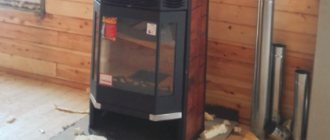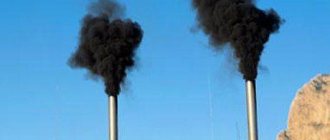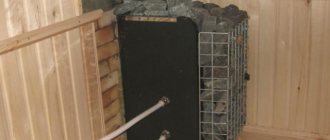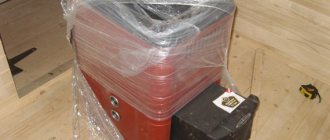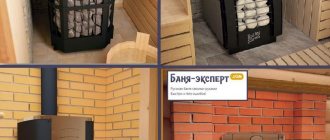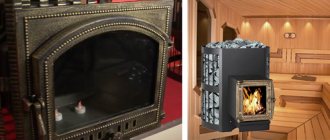Stove heating, once popular in private homes, is practically no longer used today - it has been almost completely replaced by modern heating systems. However, there are situations where brick kilns remain indispensable. Of course, we are talking about baths. And although many ready-made metal and cast iron sauna stoves are now sold, brick sauna stoves do not lose their relevance, because only they can create the atmosphere of a real Russian sauna in a steam room.
Brick stoves for baths are multifunctional, and although repairs to a brick stove are periodically necessary, this does not stop true connoisseurs of the Russian bath. They not only heat the steam room and generate steam, but also, depending on the design, can be used to heat water and heat bath rooms.
IN THE ARTICLE:
- Operating modes of brick sauna stoves
- Continuous ovens
- Batch ovens
- Which oven should you choose?
Operating modes of brick sauna stoves
According to the method of heating the stones and, accordingly, the operating mode, brick stoves for baths are divided into 2 types: continuous and periodic stoves . Regardless of the operating mode, protective screens are not required for brick sauna stoves.
Continuous ovens
The stones in such stoves are kept in an insulated metal box above the firebox. In this design, the stones are protected from soot, but they heat up slightly, only up to 300-350 degrees. The stones used are fine, the size of coarse crushed stone.
The main advantage of continuous stoves is that you can use the steam room during the combustion process ; you do not have to wait until the fuel burns out completely, as is necessary in the case of intermittent stoves.
Batch ovens
The stones in these stoves are also located above the firebox, but not in an insulated box, but on a metal grate. The stones are heated by flue gases passing through them; the temperature of the stones reaches 1000 degrees.
Due to this design, you can use the steam room only some time after the fuel has completely burned so that all the carbon monoxide has time to escape. The stones used in such ovens are large and round in shape. The total weight of the stones is at least 50 kg.
Back to contents
Periodic heaters
A good bathhouse is determined by two main factors: o convenient layout and correctly executed thermal contour of the building; o a good stove that allows you to achieve the selected temperature and humidity conditions in each room of the bathhouse and solve the issues of obtaining steam and hot water. In this article we will consider the issues of designing a sauna stove-heater of periodic action, that is, with heating of stones by flue gases passing through them. There are many designs of such furnaces. Let us consider the most commonly found designs in the literature (Fig. 1 ~1~ and fig. 2 ~2~. The stove consists (Fig. 2 ~2~) of a firebox 1, a steam chamber 2 and a ceiling between them, as well as a convective system 7 and a pipe 6. In the steam chamber, on the side of the steam room, a door is installed through which hot water is poured onto the hot stones , and steam enters the steam room through it. An adjustable ventilation grille or door for ventilation is installed above the valve. If necessary, it is opened to ventilate the room after heating the stove and closing the valve. The ceiling can be made in the form of a vault made of refractory bricks with slots or holes. A 4 DHW (hot water supply) coil can be inserted into the firebox. A layer of rounded stones of volcanic origin is laid on the ceiling with the addition of 20-30% cast iron pigs for “heat”. There are metal furnaces lined inside with refractory bricks that do not have a convective system (Fig. 3 ~3~). They are designed to heat only the steam room and prepare steam. The recommended number of stones laid on the ceiling per 1 m3 of steam room volume varies widely among various authors. I.I. Kovalevsky recommends 60-62 kg, with a backfill thickness of 20-22 cm, V.V. Timpani and G.L. Kaidanov et al. recommend 35-45 kg. Stone basalt backfill has a volumetric weight of 2800 kg/m3, or 2.8 kg/dm3. In this case, per 1 m3 of steam room volume, from 12.5-16.1 to 22.14 dm3 stones are required. If this volume is placed on 1 m2 of furnace floor, then the thickness of the backfill will be from 1.25-1.61 to 2.214 cm per 1 m3 of steam room volume. If we take the backfill thickness as 22.14 cm as a standard (according to I.I. Kovalevsky, since other authors do not indicate the thickness), then for a steam room with a size of 6 m2, a height of 2.3 m (volume 13.8 m3), when loading 62 kg per 1 m3 of steam room volume, 1.38 m2 of firebox overlap area is required, with the number of stones 35 kg/m3 - 0.78 m2, 45 kg/m3 - 1.0 m2. The same thickness of the backfill in this example was taken from the conditions for obtaining the same heating of the stones to the temperature specified by all authors. Structurally, the firebox overlap area, in these examples, is 45-50% of the area of the furnace with a convective system and 66% in furnaces without a convective system (Fig. 3 ~3~). That is, the area occupied by a steam room oven with an area of 6 m2 will be: according to Kovalevsky 1.38/(0.45 - 0.50) = 3.07-2.76 m2; according to other recommendations: 1.73-1.56 m2 and 2.2-2.0 m2. That is, the oven can occupy 26-51% of the steam room area. To reduce the size of the furnace, it is necessary to increase the thickness of the backfill. K. Mäkelä recommends making the backfill thickness 30-50 cm, which corresponds to 840-1400 kg/m2 of furnace floor. The combustion process, according to I.I. Kovalevsky, occurs at temperatures of 800-900°C for firewood and 1000-1200°C for coal, and the heating temperature of the firebox walls is approximately 200°C lower. According to tests conducted by I.S. Podgorodnikov, the temperature in the firebox of bell-type furnaces reaches 975°C. According to Yu.P. Sosnina and E.N. Bukharkin (p. 58), the heating temperature of the firebox walls during periodic combustion with coal reaches 800-900°C. Naturally, when burning wood, the temperature will be lower by about 200°C. All authors claim (including Yu.P. Sosnin and E.N. Bukharkin) that the stones are heated to a temperature of 1000-1100°C from below and 500-600°C from above (until a crimson glow). It is not clear on what basis these claims are based. In my opinion, this issue requires additional study, since it is impossible to heat stones to such a temperature in a wood-burning stove. To increase the heating of the stones, it is necessary to increase the temperature in the firebox, heat them from all sides, or reduce the thickness of the backfill. The operating principle of all furnaces is as follows: hot gases from the firebox pass through cracks (holes) in the ceiling, penetrate the layer of stones, enter the convective system and then into the pipe. The operation of the furnace depends, other things being equal, on the thickness of the filling and the volume filling factor. That is, with different thickness and size of stones, the resistance to escaping gases and heating of the stones will be different. It should be noted that, in fact, it is impossible to obtain high efficiency from sauna stoves, as well as quickly heat the stones to the required parameters. This is explained by the fact that when the heating temperature of the furnace walls and gas is equalized, the perception of heat by the furnace walls and stones decreases, and therefore the temperature of the exhaust gases increases. Structurally, the ovens are made with thick walls and therefore do not heat up much. With such stoves you can obtain a temperature and humidity regime close to that of a Russian bath. From all that has been said, the following tasks, sometimes contradictory, arise that must be solved in order to get a good furnace: o to reduce the size of the furnace, it is necessary to increase the thickness of the backfill; o increase the heating of the stones; o reduce resistance to escaping gases; o reduce the temperature of the exhaust gases, i.e. there is an increase in the efficiency of the furnace; o obtain the maximum, useful amount of heat from the amount of heat contained in the fuel. How can these problems be solved? These problems can be solved if the stove-heater is designed on the “principle of free movement of gases.” Consider the furnace diagram shown in Fig. 4 ~4~. This is a “two-tier cap” scheme. The lower hood consists of a firebox 1, in which a stone backfill 3 is laid on the slotted ceiling 2. On both sides of the ceiling there are stone-free slots 4 connecting the firebox to the steam chamber 5. Next to the firebox there is a convective system of the lower hood 6, with which the coil is installed (register) DHW 11. The fuel tank and the convective system of the lower hood are connected to each other by a dry seam 7 and a number of holes 8 in the upper zone. In the lower cap there is a channel 9 (overflow), leading to the upper cap 10. The diagram shown in Fig. 4 ~4~, corresponds to the formula “the lower tier and the firebox are combined into a single space and make up the lower cap.” The whole idea of a dry seam and stone-free passages into the upper part is to ensure a uniform elevated temperature in the volume of the cap and uniform heating of the stones from all sides, regardless of the thickness of the backfill, including from above. Divide the flow of exhaust gases into cold and hot components in the hood, without increasing the resistance to the passage of the gas flow. If an electric heater is used as a source of thermal energy, then there is no need to remove combustion products (accepted conditionally, for better understanding). In this case, the transfer of thermal energy will be due to the natural forces of nature, even with a closed pipe. This system has all the wonderful properties formulated in the article “Once again about the system” https://www.stove.ru/new/index.php? lng=0&rs=16. In the absence of a dry seam and free passages, the entire flow is pulled through the stones with increased resistance and preferential heating of the lower part of the backfill, and the operation of the furnace and the heating of the stones will significantly depend on the thickness of the backfill, all other things being equal. It is known that a channelless convective system has high thermal properties and efficiency. The principle of operation of this scheme is as follows: Flue gases, passing through cracks free of stones (as well as through the stone backfill), fill the bell, with the hottest gases entering its upper part, and the coldest, heaviest gases passing through the “dry seam” the bottom of the cap (without getting into it) into the overflow channel. In the upper part of the bell, a zone with elevated temperature is created, which contributes to the completion of the combustion reaction (burnout of the gaseous component of the fuel), that is, increasing the efficiency of energy extraction from the fuel. Heating of the stone backfill occurs from above and below, which improves its heating, while the operation of the system does not depend on the thickness of the backfill. That is, the resistance to escaping gases increases slightly. To obtain high-quality steam, the stones must be heated strongly. This requires heating the oven for a long time, sometimes much longer than in a conventional oven. It is known that with an increase in the duration of the firebox, the efficiency of the furnace decreases due to a decrease in the perception of heat from hot gases by the walls of the furnace and stones (the temperature of the gases and walls is equalized). In this case, it is necessary to lower the temperature of the gases escaping into the pipe. This is achieved in two ways: a hot water supply (DHW) coil is installed in the convective system of the lower hood; as well as a device above the first cap of the second cap. The coil and hood absorb excess heat that occurs when the furnace fire time increases. The coil (register) must be designed so that the forces arising from thermal expansion do not destroy the furnace and that it can be simply replaced. This is achieved by giving it a zigzag shape or by installing inlet and outlet pipes on the opposite side of the furnace. It should be designed and installed in such a way that when filled with water, no air lenses appear in it. Otherwise, when the water in the lens heats up, the pressure increases and water hammer occurs. You can regulate water heating by changing the speed of water circulation when installing a valve on the return pipe, or by changing the direction of gas movement when the coil power is low. The valve cannot be installed on a straight pipe, as the resulting pressure in a closed system can rupture the pipes. Methods for regulating water heating: o “cap within a cap”, the coil is placed in a small cap, at the top of which a water heating control valve is installed, the small cap is placed in a larger cap; o “in a glass”, the coil is placed in a “glass”, in the bottom of which a control valve is installed, the glass is placed in the lower cap; o “in the second cap”, the coil is placed in the second horizontal cap, in the upper part of the partition between the caps, a control valve is installed. About 10-12 years ago we made a stove according to this scheme in a public bathhouse in the village. Polovinny, near Yekaterinburg. The stones were heated to white heat, the oven heated 1.0-1.5 m3 of water. People's reviews of the bathhouse were very positive. The disadvantage of such a stove is its fragility. Stones, when heated and cooled, expand and contract, as a result of which, like wedges, they destroy the ceiling (vault) and the walls of the furnace. Therefore, it is very important to have rounded stones to reduce the forces that destroy the stove. Stones are also affected by radiant heat, so for better perception of this heat, choose black stones. In practice, water is sometimes thrown onto cooled stones. High humidity erodes the furnace masonry. All our sauna stoves are constructed using the same scheme, with stones enclosed in an oven (steam generator) made of heat-resistant steel. The stones are heated to a lower temperature through the metal wall. In this regard, to obtain higher quality steam, various steam generator design solutions are used. With reduced heating of the stones, you can get very high-quality steam, including dry, superheated steam, with a temperature close to critical (374°C). The same oven can create different temperature and humidity conditions in the steam room. These stoves are durable. It should be noted that in Fig. 4 ~4~ only the furnace diagram is shown. In practice, the layout of the furnace, both in plan and height, can have many different solutions. When designing a stove, you must adhere to the recommendations given in the article “Basics of stove design” https://www.stove.ru/new/index.php?lng=0&rs=15.
Which oven should you choose?
It would seem that batch stoves are not as convenient to use as, for example, gas sauna stoves or gas-wood stoves for a sauna. To some extent, this is true, but a real Russian bath is obtained only with periodic brick stoves , since only these stoves provide that “light” steam without jumps in humidity in the steam room.
Constant heating stoves are more suitable for dry saunas , where high temperature is important and there is practically no humidity.
Back to content
Did you like the article? Recommend to friends:
In what cases is it used?
It is worth noting that there is no need for lining if the stove is needed for intermittent heating of a summer house or cooking over an open fire (barbecue, kebabs, etc.). In these cases, there is no need for additional protection, since the destruction that occurs during use is minimal. The lining is recommended for products used for long-term and constant heating of premises or cooking in various kinds of cafes and restaurants, where the required temperatures are continuously maintained in the firebox - for example, “Russian” stoves and the like. Lining is especially necessary when using high-calorie fuel, which during combustion releases a large amount of energy, as a result of which an extremely high temperature regime is observed in the firebox.
Main selection criteria
The stove must be powerful to heat the air in remote rooms to the required temperature. It is better to choose universal models. The heating stove-stove is simple, affordable, and runs on any fuel. For bath structures, the problem remained in the huge overall dimensions. The combustion process is not controlled or automated. There are always combustion products.
When heating at the same time, the location of the furnace plays a big role. The firebox, in which fuel is loaded and ash and coals are removed, is located in the accessible part of the dressing room. The other part goes into the greenhouse, the washing compartment. Maximum heating necessarily occurs in the greenhouse portion. The temperature of this part is higher than all other places. The location of the water supply depends on the design of the bathhouse. The heated water disperses throughout the bathhouse and goes into other rooms to warm the walls and air.
The following can be used as an energy source:
- wood;
- solid fuel;
- gaseous fuel;
- electricity.
note.
The most environmentally friendly fuel is firewood. It is expensive to burn with wood alone; it is combined with coal.
Purchase, installation, installation of electrical equipment is more expensive. During operation, it does not form combustion products, takes up less space, and is controllable.
Brick lining
Do-it-yourself furnace lining from fireclay bricks is carried out taking into account the following features:
- The brick is carefully laid out “edge to edge”, without shifting the masonry elements relative to each other, along all the walls of the internal firebox.
- The seams between individual bricks are filled with a mortar based on fireclay and clay.
- If the main masonry is also made of brick, then the lining and main layers are joined using one vertical seam, but without ligation.
- If the material of the firebox itself is metal (cast iron or steel), then a small gap must be left between its walls and the masonry, designed for thermal expansion of the metal, otherwise regular heating and cooling may soon destroy it.
Finishing with fireclay bricks occurs according to the scheme - along all walls with a gap, taking into account the expansion of materials
ATTENTION! Internal furnace masonry from fire-resistant red brick is also possible, but it is impossible to mix types of bricks (fireclay plus fire-resistant), since they have different indicators of linear expansion and thermal conductivity, which will make the building short-lived.
Old fireclay brick masonry is subject to regular inspection and repair of worn areas, which is carried out by grouting with a mortar of fireclay and aluminous cement.
Coating with solutions
Coating with refractory solutions gives an even thinner layer of lining. This method is characterized by the following nuances:
- To prepare solutions, dry compositions of fireclay, mullite or corundum mixtures are usually used, which are then diluted with water to the desired consistency.
- After application, the solution must be fired under natural conditions (while the oven is operating) or using a blowtorch. In the second case, work is carried out until a hard crust appears.
IMPORTANT! The advantage of the mortar method is also the creation of absolutely monolithic surfaces, which provide better protection of materials from the effects of fire. However, such a monolith will require repairs faster than stone and brickwork.
Pre-thought-out stove protection will guarantee warmth and comfort for many years
Lining: no more questions
Having considered this issue, we can conclude that the lining of stoves used for domestic purposes mainly represents protection of the stove structure from the destructive effects of high temperatures. This is a kind of screen that prevents the heat flow of an open fire from directly affecting the walls of the stove.
Unlike “household” linings, industrial linings, for example, the lining of an induction furnace, are intended to significantly reduce heat losses, protect the furnace casing from direct exposure to high temperatures and protect against direct contact with molten metal.
Having considered this issue, we hope you will draw the right conclusion, which will help you when building stoves with your own hands.
Manufacturing lining and material properties
In production, in metallurgy, the lining of an induction furnace is made using special, pressed fireclay bricks. They are very wear-resistant, do not shrink and withstand thermal shocks well. The use of fireclay bricks made it possible to achieve great cost savings and greatly reduce the cost of the metal production process.
Induction oven
Induction oven
The table shows the properties of some refractory materials
| Material | Density kg/m3 | Maximum operating temperature °C |
| Chamotte | 1800-2000 | 1300 |
| Clay brick | 1600 | 700 |
| Vermiculite | 150-250 | 1100 |
| Basalt wool | 100 | 750 |
| Kaolin is dense | 2400-2500 | 1400 |
Household problems - lining as a solution
In everyday life, people usually have to solve simpler problems. At the very last stage, the burning of the coals, the bottom of the metal stove overheats, sometimes red hot. A man decides to cover the overheating wall from the inside with his own hands.
But even in this case, you have to decide to what level to lining, whether to leave a gap and how to secure the bricks?
Specifically in this situation, the issue can be resolved as follows:
- If the width of the firebox allows, fireclay bricks of a standard size are laid along its perimeter - 250X150X65 mm. In this case, the brick is laid flat against the wall. Can be laid vertically with a height of 250 mm or horizontally with a height of 120 mm.
- In order to securely fix the bricks together, a simple method is used. Using a grinder, a cut is made in part of the joint, and the bricks are held together using an inserted metal spike of a suitable size.
Lining device: temperature and metal
Particular attention should be paid to the fact that the thermal linear expansion of metal is much greater than that of brick. Therefore, all metal parts exposed to heat must have free space for expansion.
Our information: the absence of a gap between the metal wall of the furnace and the lining leads to destruction of the lining.
When installing this lining, the gap is sealed with basalt or kaolin wool, twisted into bundles, cords or in the form of a compressed sheet. Asbestos can be used for this purpose.
Wrong defense. Consequences
This picture occurs very often. The metal stove is lined with bricks using clay mortar, and without any gap. This is motivated by ensuring safety and improving the heating of the furnace.
Metal stove with brick lining
This is completely misleading!
- Firstly, brick is very heat-intensive .
- Secondly, brick has low thermal conductivity . What happens during operation of such a furnace?
The brick simply plays the role of thermal protection. The main heat generated by the stove simply flies out into the chimney due to excess in the firebox. In addition, the absence of a gap prevents the penetration of cooling air to the metal walls of the furnace, which definitely leads to their burnout, and the expansion of the metal will lead to cracking of the brick protection.
As a result, carbon monoxide will begin to enter the room.
Not always brick: lining mixtures
Recently, “modeled” sauna stoves of various shapes have become very popular. Basically, such stoves are installed in bathhouses made in a stylized “fairytale style”. Such stoves are made using an ancient method called adobe.
After the clay has dried naturally, the oven is fired from the inside using firewood. The outer part is burned using blowtorches until a crust forms. It is very convenient to line such furnaces using special compounds.
These can be dry mixtures:
- Fireclay.
- Mullite.
- Corundum.
These compositions can be perfectly used for the on-site production of various refractory products, including linings. A solid, monolithic lining made from these materials far exceeds in quality seam furnace linings made with fireclay bricks.
On-the-job lining
Currently, there are a number of technologies in which lining or restoration of the lining is carried out without stopping the furnace. The compositions are applied by “spraying” directly onto a hot surface or by gunning.
Our information: shotcrete is a method in which concrete or other mixture is applied layer by layer to a structure using compressed air and a special shotcrete installation.
This method is mainly used in production, which allows lining work to be carried out, if necessary, without stopping the production process.
Brick kiln: problems with overheating
We have already considered the need for lining the combustion part of metal stoves, but what about brick stoves? What happens to brick kilns when they are overheated?
Cracks in a brick kiln
There is a concept - thermal cracking . This phenomenon applies both to the material of the stove itself and to its seams.
- The inner walls of the furnaces, heating up from the hot gases produced by the burned fuel, expand and begin to expand the outer “cold” walls.
- The outer walls of the furnace act as a “bandage”, maintaining the dimensions of the furnace and maintaining its integrity.
- The more the oven heats up, the thinner the “bandage” becomes, which is already under heavy loads, and therefore becomes even less durable.
- When the furnaces “overheat,” the outer walls begin to “move apart” under internal pressure.
- Cracks form and even individual bricks break.
Local solution: main disadvantages
It is worth noting that in a brick kiln clay is used to connect the bricks together. Therefore, either the seams themselves or the contact with the bricks rupture due to low adhesion. In any case, a seam in which a mortar with a high sand content was used will expand significantly more than a brick.
This situation is further complicated by the fact that the thermal coefficients of bricks and joints generally differ greatly from each other. This is understandable, because the bulk of the furnace solution is prepared directly on site. Stove makers primarily strive for the plasticity of the solution to the touch and the absence of cracking when drying and compressing.
Our reference: the correct assessment of the mortar for compliance with the bricks used can be checked as follows. Two bricks are held together with a solution; after drying, the test block is calcined in an oven, followed by an assessment for adhesion, cracking and peeling.
Methods and options for preparing the right solutions
Of course, this method requires a certain amount of time, because it is not a fact that you will get the required solution the first time.
Therefore, if you still decide to use this testing method, prepare several “blocks” for testing with different solutions. Then all you have to do is choose the most optimal one. The main thing is not to confuse and forget which solution is which.
Another good option is to use the most common clays for the solution, mixed with powder made from ground bricks.
If you use only firewood when burning, the use of special fireclay clays with a high content of kaolinite is not entirely advisable, since the temperature of the firewood is not sufficient for kaolin to sinter into mullite. But if you use coal, then this option will be completely justified.
Materials used
Refractory materials for lining furnaces, depending on the ingredients included in the raw material composition, are divided into the following classes:
- A - products based on materials of natural origin or a synthetic composition with the addition of an organosilicon binder;
- B - a special type of clay (fireclay) is used as the main ingredient;
- C - other components of refractory substances.
Products and compositions for lining a class B furnace (bricks, blocks, mastics, etc.), the basis of which is fired fireclay clay, are available, inexpensive, and therefore are most popular. To increase heat resistance, portions of quartz sand, sandstone and other types of rocks, the strength of which remains unchanged at any heating temperature, can be introduced into the raw materials during their production.
As additional protection, materials in the form of a roll, plate or sheet are used for fireclay products. They are laid between layers of masonry made of heat-resistant and ceramic products. The list of such materials for furnace lining, which are based on white clay, includes:
- basalt wool;
- dense kaolin;
- mullite - siliceous mats;
- vermiculite and a number of other products.
Dry mixtures are used to make fire-resistant mortar, which is used to coat the surfaces of the combustion bunker and other masonry elements. They fill the cavities of technological clearances and gaps that compensate for the linear expansion of the structural parts of the metal furnace.
Refractory materials for lining furnaces also include heat-resistant aluminosilicate adhesive mass, which is used to glue refractories in sheet or roll form. This glue is also used for fireclay masonry and for coating walls made of bricks with low heat resistance with a thin layer.
Is it necessary to soak fireclay bricks before laying?
Even experienced stove makers do not have a clear answer to this question. However, having studied the physical properties of fireclay, you can be convinced that in some cases, before making the furnace lining, it is simply necessary to moisten the masonry material:
- when the masonry is done with used bricks. During previous use, the pores of the material became clogged with particles of dust and masonry mixture, and in order to open the capillaries in its structure, the brick is soaked. After the brick is removed from the container with water, you should wait until all the liquid has drained from it, and only then use it for masonry work;
- when building a heating device in the summer heat, but with high humidity in the fall or spring, it is better not to soak the brick.

